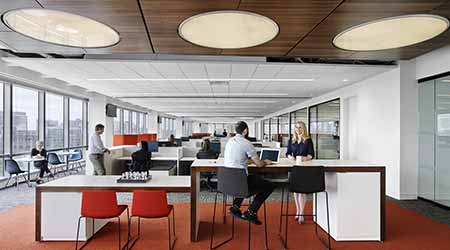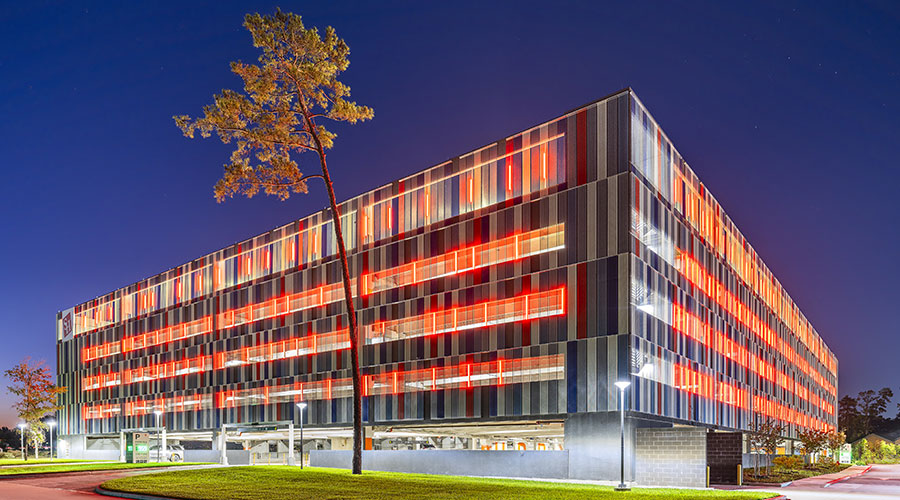 Nasdaq’s LEED Platinum Philadelphia office achieved a lighting power density 51 percent better than ASHRAE 90.1-2007. The space uses LEDs along with digitally addressable dimming controls, including daylight-responsive dimming controls in perimeter spaces. (Designer: HOK. Lighting design: The Lighting Practice.)©2017 Eric Laignel Photography
Nasdaq’s LEED Platinum Philadelphia office achieved a lighting power density 51 percent better than ASHRAE 90.1-2007. The space uses LEDs along with digitally addressable dimming controls, including daylight-responsive dimming controls in perimeter spaces. (Designer: HOK. Lighting design: The Lighting Practice.)©2017 Eric Laignel PhotographyImprovement to Daylight Harvesting Technology Yields Energy Savings
New energy codes require a significant reduction in artificial lighting. Here's how FMs should consider new daylight-responsive dimming controls and other tech
Today’s ultra-efficient lighting options provide facility managers with multiple ways to save energy, while simultaneously improving the indoor environment. Advances in daylight harvesting, solid-state lamps, and advanced lighting control systems help facility managers meet new energy code requirements and reduce lighting energy loads substantially. As an added plus, the better lighting conditions created by today’s ultra-efficient solutions also can improve the comfort and productivity of building occupants.
Traditional office lighting often remains on even in areas flooded with sunlight. Tapping natural light offers energy savings opportunities. Daylight harvesting also has health benefits for building occupants and can result in better productivity and worker retention for the enterprise.
Daylight harvesting, required under ANSI/ASHRAE/IES 90.1—2016, allows a significant reduction in artificial lighting. Under the new 90.1 standard, a sensor that adjusts lighting in response to available daylight is required for sidelight and skylight zones. Lighting fixtures in both primary and secondary zones must be independently controlled; window (sidelighted) zones must be controlled separately from skylighted (top lighted) zones.
“Newer energy codes require daylight-responsive dimming controls,” says Emad Hasan of The Lighting Practice. “Many building owners may not be aware the code requires this, and that there are few exemptions.”
Hasan emphasizes the importance of educating facility managers early in the design process about code requirements. “Setting expectations in the beginning will allow the costs associated with these controls to be incorporated in construction and operations budgets,” says Hasan.
Cost effectiveness
Lawrence Berkeley National Laboratory (LBNL) assessed the performance of daylight harvesting at five federal building sites. LBNL researchers found daylight harvesting could yield average annual energy savings of 27 percent and simple payback in as little as four years. The five sites chosen for intense study encompassed a diverse set of agencies, occupancy patterns, work styles, and baseline energy use. LBNL’s study found that workspace design, interior floor plan, and occupant education and buy-in were critical to efficient application of natural light.
Though payback periods varied, LBNL calculated that daylight harvesting was cost effective for new and retrofit federal buildings at an installed cost of $1.40 per square foot, with a utility rate equal to the national average of $0.10/kWh, provided dimming ballasts were already in place. The LBNL-recommended target for daylight harvesting application was new or retrofit projects with an existing average lighting power density greater than 1.1 watt per square foot and annual lighting energy use intensity greater than 3.3 kWh per square foot.
Robert Guglielmetti, an engineer at the U.S. Department of Energy’s (DOE) National Renewable Energy Laboratory (NREL), concedes that daylight harvesting often is the ugly duckling overlooked in ultra-efficient lighting solutions because it requires a commitment that starts in predesign considerations, long before the architect begins first sketches for the facility. To continue optimum benefits, daylight harvesting commissioning also needs to extend as long as the building is occupied.
Best practices begin with how the building is situated on the site, according to Guglielmetti and go far beyond window and light diffuser placement. North facing windows primarily receive indirect light, providing functional light and requiring minimal shading. South facing windows receive direct light that may need shading.
Designing for daylighting encompasses many elements, Guglielmetti says. At NREL’s 360,000-square-foot Research Support Facility (RSF), which has a LEED Platinum rating, everything from the exterior window treatments to the height of cubicle walls, furniture, and paints “factor into a hugely successful daylight harvesting experience in the RSF building,” Guglielmetti says
Lighting is separately metered in the building, as are other energy uses. The building was designed with a lighting power density (LPD) of 0.6 watts per square foot. But actual LPD currently is 0.15 watts per square foot, Guglielmetti notes.
“A Literature Review of the Effects of Natural Light on Building Occupants” by L. Edwards and P. Torcellini for NREL outlines a variety of ways that daylight harvesting can improve performance in corporate and institutional buildings.
“The pleasant environment created by natural light decreases stress levels for office workers,” that study concludes. It also notes that students in daylit rooms achieved better test scores than those in windowless or poorly lit classrooms. In retail establishments, customers stay longer shopping. In healthcare facilities, Edwards and Torcellini conclude, “natural light improves patient recovery rates and allows for proper vision for the elderly in assisted living facilities.”
Related Topics:














